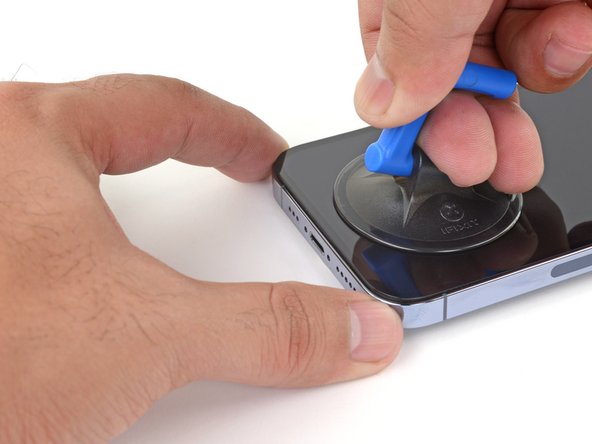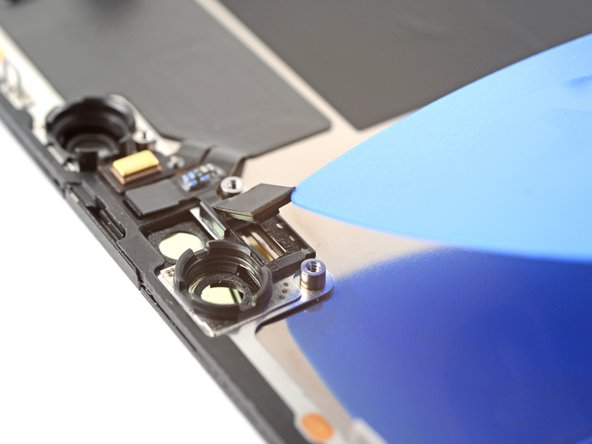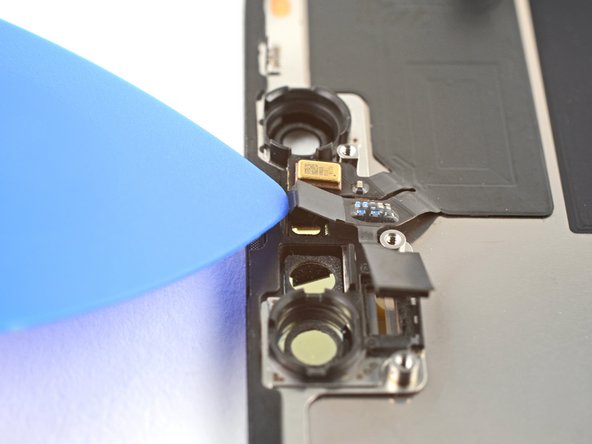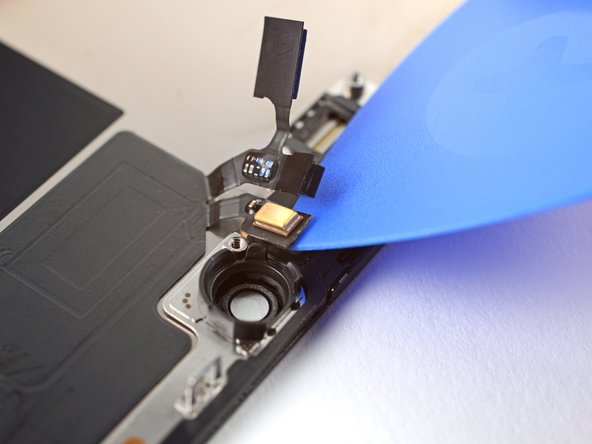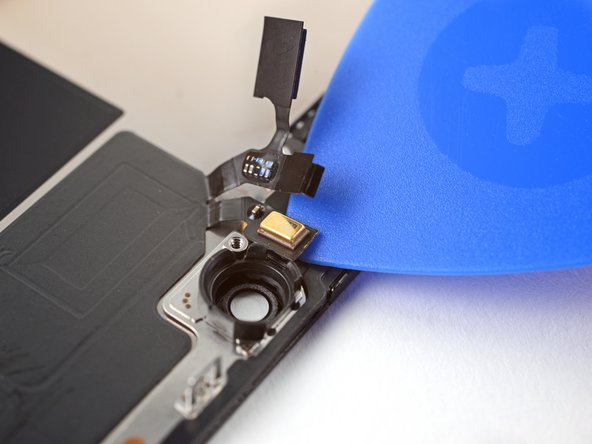iPhone 13 Pro Screen Replacement
Duration: 45 minutes
Steps: 33 Steps
If your iPhone 13 Pro screen is cracked, unresponsive, or not showing anything when your phone's powered up, this guide is your go-to for bringing it back to life with a shiny new display assembly. Quick heads up: on iOS 17.6 and earlier, replacing the screen will disable True Tone and auto-brightness, even with an original Apple screen. Also, Face ID won't work unless you're on iOS 15.2 or newer. But if you're rocking iOS 18 or later, you can use Apple's Repair Assistant to calibrate your new screen and get that True Tone magic back, as long as it's an Apple screen. If you're feeling stuck at any point, you can always schedule a repair to get it done.
Step 1
Heads up: Before diving in, make sure your iPhone battery is under 25% charged. A fully charged lithium-ion battery is like a ticking firecracker—puncture it by accident and things could get hot (literally). Stay safe and keep it cool!
Opening your iPhone’s display can break its waterproof seals, so be sure to have new seals ready before you move on. If you’re reassembling your phone without swapping out the seals, just be extra cautious about keeping it away from liquids.
- Before you start, give your iPhone a nap—shut it down completely.
- Flip it over and unscrew the two 6.8 mm pentalobe P2 screws hanging out at the bottom edge.
Step 2
Pushing the opening pick in too deep can cause damage to your device—let’s avoid that! Mark your pick to know exactly how far to go.
Feel free to mark the other corners of your pick with different depths for extra precision.
Or, tape a coin onto your pick about 3 mm from the tip to use as a handy depth guide.
- Mark the opening pick 3 mm from the tip with a permanent marker so you know exactly where to start your magic.
Step 3
Pop on some safety glasses to keep your eyes safe from any rogue glass bits that might fly around during the repair.
If your iPhone's screen has seen better days with a crack, let's keep those pesky glass shards in check and avoid any accidental pokes while you tackle the repair. A little tape goes a long way in containing the glass and adding some much-needed strength when you're prying and lifting the screen.
And if you're really in a bind, a little superglue can help stick that suction cup right where you need it on the screen. Just remember, if you find yourself in a tough spot, you can always schedule a repair.
- Cover the iPhone screen with overlapping strips of clear packing tape, making sure the whole front is protected.
- If the suction cup refuses to cooperate in the next steps, grab a sturdy piece of tape—duct tape works great—fold it into a handle, and use that to lift the screen instead.
Tools Used
Step 4
The next three steps show you how to use the Anti-Clamp, a handy tool we created to make opening up your device a breeze. If you don’t have the Anti-Clamp, don’t worry—just skip ahead three steps for another method.
Need a hand with the Anti-Clamp? Check out this guide for all the deets on how to use it.
If your iPhone’s surface feels too slippery for the Anti-Clamp to grip, use the included tape pad to add some extra friction. It’ll help the tool hold tight while you work.
- Pull the blue handle back to release the Anti-Clamp's arms—think of it like unlocking a treasure chest!
- Slide those arms right over the left edge of your iPhone, like you're giving it a gentle hug.
- Now, grab those suction cups and place them near the bottom edge of your iPhone—one on the front, one on the back. Just like placing the perfect stickers!
- Squeeze the cups together, applying a little suction magic to make sure everything sticks where it should.
Step 5
Keep those suction cups in check! If they start slipping out of sync, just loosen them up a little and gently guide them back into place. No biggie—just a little nudge, and you're all set!
- Slide that blue handle forward to lock those arms in place.
- Give the handle a full clockwise spin (yep, all the way around) until you see the cups start to stretch.
Step 6
Take it easy, and remember: twist no more than a quarter turn at a time. Give it a minute to breathe between each turn. Let the Anti-Clamp and a little patience do their magic for you.
Place your iPhone on a solid surface before you dive in. A stable base makes all the difference!
Not sure how to work a hair dryer like a pro? We've got you covered! Check out our full guide for tips and tricks.
If the Anti-Clamp isn't creating enough space, crank up the heat a little more and give the handle a quick quarter turn to loosen things up.
- Warm up the bottom edge of your iPhone with a hair dryer until it’s a little too toasty for comfort.
- Give it a minute—let that sticky adhesive loosen up and show you a gap you can work with.
- Once the Anti-Clamp opens things up, slide an opening pick under the screen like a pro.
- You can skip the next three steps. No need to flex your repair skills just yet!
Tools Used
Step 7
Keep your hair dryer moving—don’t let it hang out in one spot too long!
- Grab your hair dryer or heat gun and warm up the bottom edge of the iPhone for about 90 seconds, or until the screen feels just a bit too toasty for comfort.
Tools Used
Step 8
The adhesive holding the display is seriously tough, so cracking that first gap might feel like arm wrestling with your device. If it’s not budging, hit it with a bit more heat and gently wiggle the screen up and down—this should soften up the glue enough to let you slide in your opening pick. Patience and a little muscle go a long way!
- Stick a suction handle near the bottom edge of your phone—just keep it away from the very edge of the glass.
- Give the suction cup a steady, upward pull to open up a tiny gap between the screen and the back.
- Slide an opening pick right into that gap—like sneaking a chip into a dip!
Tools Used
Step 9
- Grab a hair dryer and warm up the right edge of your iPhone (that's the side with the power button) for about 90 seconds, or until it’s a little too hot to touch. Just enough heat to get things moving!
Tools Used
Step 10
Keep your pick to a maximum of 3 mm, or you might accidentally poke something important inside.
- Gently glide the opening pick around the bottom right corner of your iPhone to break free that pesky adhesive.
- Keep sliding up the right edge of the iPhone until you hit the top right corner.
- Once you reach the top right corner, just leave the pick there for now and let's keep going!
Step 11
- Grab a hair dryer and give the top edge of your iPhone a warm hug for about 90 seconds, or until it feels just a tad too hot to touch. You're doing great!
Tools Used
Step 12
Be careful not to push your pick more than 3 mm in, as it could mess with those delicate top sensors.
- Gently slide the opening pick around the top right corner of your iPhone to break free that stubborn top adhesive.
- Keep the pick wedged in the top left corner while you move on to the next steps.
Step 13
Heads up! There are some fragile cables hugging the left edge of your iPhone. Avoid sliding your pick in there to keep everything safe and sound.
Step 14
- Grab your hair dryer and warm up the left side of your iPhone for about a minute and a half, or until it’s just a bit too warm for comfort. This helps loosen things up for the next step.
Tools Used
Step 15
Be careful with those cables along the left edge—they're a bit like a shy cat, super easy to spook with a pick! Instead, let's switch things up and use this alternate method to tackle that pesky left adhesive.
Gently twist with steady pressure to loosen things up.
If the adhesive is being stubborn, try warming up the left edge again to make it easier to separate.
- Slide a second opening pick into the bottom left corner of your iPhone.
- Gently twist both picks at the same time until you hear the satisfying sound of the left edge clips popping free.
Step 16
Hold your horses on fully separating the display! There are some delicate ribbon cables still keeping it connected to the iPhone's logic board, and we don't want to accidentally pull any of those.
- Take off your suction handle from the screen, like a magician revealing their secrets!
- Gently lift your iPhone's display from the right side, swinging it open like the front cover of an exciting storybook.
- Prop that display up against something solid, so it's there to support you while you tackle the ins and outs of your phone.
- When it’s time to put things back together, lay the display in its rightful spot, align those clips along the top edge, and give that top edge a gentle press to snap it into place. If it’s being a little stubborn and doesn’t click easily, take a peek at those clips around the display’s perimeter to check if they’re bent or misaligned.
Tools Used
Step 17
Keep a careful eye on each screw during this repair, making sure every one goes back exactly where it came from—your iPhone will thank you!
- Grab your trusty Y000 screwdriver and go ahead and unscrew those three 1.3 mm screws holding down the battery connector cover. You've got this!
- Now, here's a little tip: while you're putting everything back together, it's a great time to power on your iPhone and make sure everything's working like a charm before sealing that display back in place. Just remember to power it down completely before you dive back into the repair!
Step 18
- Pop off the battery connector cover like you're peeling off a sticker. Easy does it!
Step 19
Be gentle around the black silicone seal you see near these board connections. It’s there to help keep out water and dust, so try not to mess it up while you work.
- Grab a spudger or just use your fingernail, and pop that battery connector up from its spot on the logic board—careful, no superhero moves needed.
- Gently nudge the connector away from the logic board. This keeps it from sneaking back into place and powering up your phone mid-repair. Safety first, right?
Tools Used
Step 20
- Take the pointy end of your spudger or a clean fingernail and gently pop the display connector up from its spot on the logic board—think of it like opening a tiny trap door.
- When it’s time to reconnect, line everything up and press down on one edge until you hear that satisfying click, then do the same on the other edge. Skip pressing right in the middle—those pins are delicate! Misalignment can bend them, and that’s a one-way ticket to trouble.
Tools Used
Step 21
- Grab your trusty Y000 screwdriver and unscrew the two tiny 1.1 mm screws holding down the front sensor connector cover.
- Switch over to your Phillips screwdriver and take out the last two screws from the cover:
- One is a 1.5 mm screw—don't blink, it's easy to miss!
- And the other is a 1.8 mm screw—slightly beefier, but still no match for you.
Step 22
- Carefully lift off the front sensor connector cover to get things moving!
Step 23
- Grab your trusty spudger and poke that pointed end right into the front sensor assembly cable connector to give it a gentle disconnect. You've got this!
Tools Used
Step 24
- Take the screen off carefully.
- When putting everything back together, feel free to stop here if you want to swap out the waterproof adhesive around the display edges.
Step 25
Next up: moving the front sensor assembly to your new screen. If your new screen already has this part installed, you can skip ahead and save yourself some time. Otherwise, let’s get that sensor swapped over!
- Grab your Y000 screwdriver and take out the three 1.4 mm screws holding down the front sensor assembly bracket.
Step 26
- Grab your tweezers or just use your fingers to gently lift off the front sensor assembly bracket. Nice and easy, you're almost there!
Tools Used
Step 27
You can use a hair dryer, heat gun, or hot plate, but keep it cool! The display is pretty sensitive to heat, so let's avoid any overheating shenanigans.
- Warm up your iOpener and let it chill on the top edge of the screen for a couple of minutes.
Tools Used
Step 28
- Carefully slide an opening pick between the ambient light sensor and its snug home in the screen.
- Gently pry upwards with the pick to separate the ambient light sensor from the screen. Take it slow—you’ve got this!
Step 29
- Slide an opening pick gently between the proximity sensor and its little nook on the screen.
- Gently pry up with the pick to lift the proximity sensor free from the screen.
Step 30
- Gently nudge the proximity sensor cable out of the way using tweezers or your fingers—no need to wrestle with it, just a little maneuver to clear the path.
Tools Used
Step 31
- Slide an opening pick underneath the microphone cable, right next to the microphone (you'll spot it as the metal rectangle).
- Gently glide the opening pick around the edge of the microphone to break free its sticky grip.
Step 32
If the adhesive's lost its warmth, just pop a heated iOpener on the assembly for about a minute to loosen things up before moving forward.
- Slip an opening pick under the left side of the front sensor assembly.
- Gently slide the pick under the assembly to separate it from the frame. Easy does it!
Tools Used
Step 33
- Double-check that your new replacement part matches the original—you might need to transfer any leftover components or peel off adhesive backings before putting it in.
- To put your device back together, just reverse the steps you followed earlier.
- Once you've completed your repair, some parts might need a quick calibration. If that's the case, head to Settings → General → About → Parts & Service History, tap Restart & Finish Repair, and follow the on-screen instructions to finish up. (Only available if you're using iOS 18 or later!)
- Got old parts or e-waste lying around? Take them to an R2 or e-Stewards certified recycler. Help keep the planet clean!
- If your repair didn't go quite as planned, don't worry! Try troubleshooting with some basic steps, or reach out to our community for extra help. And if things are still tricky, you can always schedule a repair.






















